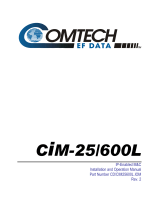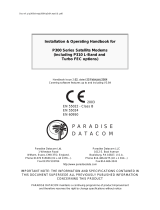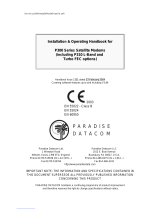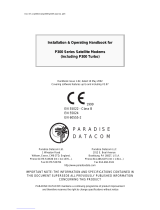Page is loading ...

Part Number MN/CDM600L.IOM Revision 0
IMPORTANT NOTE: The information contained in this document supersedes all previously published
information regarding this product. Product specifications are subject to change without prior notice.
CD
M
-
600L
Open Network Satellite Modem (2.4 kbps – 20 Mbps
)
Installation and Operation Manual
(For Firmware Version 1.1.1 or higher)


\\tempefs1\cs_vol\tpubs\manuals\released_word\modems\cdm600lrev0dr\errata a.doc
1
Errata A
Comtech EF Data Documentation Update
Subject:
Changes to power consumption and fusing information
Date:
May 30, 2003
Document:
CDM-600L Satellite Modem Installation and Operation Manual,
Rev. 0, dated May 21, 2003
Part Number:
MN/CDM600L.EA0
Collating Instructions:
Attach this page to page xi
Comments:
The following changes provide updated information for page xi. This information will be
incorporated into the next revision.
Change Specifics:
F
USES
The CDM-600L Satellite Modem is fitted with two fuses, one each for line and neutral
connections. These are contained within the body of the IEC power connector, behind a small
plastic flap.
• Use T3.15A, 20mm fuses.
IMPORTANT
For continued operator safety, always replace the fuses with the
correct type and rating.


CDM-600L
Open Network Satellite Modem (2.4 kbps – 20 Mbps)
Installation and Operation Manual
(For Firmware Version 1.1.1 or higher)
Part Number MN/CDM600L.IOM
Revision 0
May 21, 2003
Copyright © Comtech EF Data, 2003. All rights reserved. Printed in the USA.
Comtech EF Data, 2114 West 7th Street, Tempe, Arizona 85281 USA, 480.333.2200, FAX: 480.333.2161
Comtech EF Data is an ISO 9001
Registered Company.

CDM-600L Satellite Modem Revision 0
Preface MN/CDM600L.IOM
ii
This page is intentionally blank

iii
Table of Contents
CHAPTER 1.
INTRODUCTION .............................................................................................1–1
1.1 STANDARD FEATURES ...............................................................................................1–2
1.1.1 AUPC ......................................................................................................................1–2
1.1.2 Software – Flash Upgrading ...................................................................................1–2
1.1.3 Verification ..............................................................................................................1–3
1.1.4 Data Interfaces........................................................................................................1–3
1.2 MAJOR ASSEMBLIES...................................................................................................1–3
1.3 FAST OPTIONS AND HARDWARE OPTIONS .............................................................1–4
1.3.1 FAST Accessible Options .......................................................................................1–5
1.3.2 FAST System Theory..............................................................................................1–5
1.3.3 Implementation .......................................................................................................1–5
1.3.4 Hardware Options ...................................................................................................1–5
1.3.5 Supporting Hardware and Software........................................................................1–6
1.4 COMPATIBILITY............................................................................................................1–6
CHAPTER 2. INSTALLATION ..............................................................................................2–1
2.1 UNPACKING..................................................................................................................2–1
2.2 MOUNTING....................................................................................................................2–2
2.3 CONFIGURATION .........................................................................................................2–4
2.4 SELECT INTERNAL IF LOOP .......................................................................................2–4
2.5 CONNECT EXTERNAL CABLES ..................................................................................2–4
CHAPTER 3. FUNCTIONAL DESCRIPTION........................................................................3–1
CHAPTER 4. PHYSICAL DESCRIPTION .............................................................................4–1
4.1 INTRODUCTION............................................................................................................4–1
4.2 FRONT PANEL ..............................................................................................................4–1
4.3 REAR PANEL ................................................................................................................4–2
4.4 DIMENSIONAL ENVELOPE ..........................................................................................4–6
CHAPTER 5. CONNECTOR PINOUTS................................................................................5–1
5.1 CONNECTOR OVERVIEW............................................................................................5–1
5.2 OVERHEAD INTERFACE CONNECTOR (P3A) ...........................................................5–3
5.3 DATA INTERFACE CONNECTOR (P3B) ......................................................................5–4
5.4 AUDIO INTERFACE CONNECTOR (P4A) ....................................................................5–5
5.5 REMOTE CONTROL INTERFACE CONNECTOR (P4B).............................................5–5
5.6 IDR BACKWARD ALARMS CONNECTOR (P5A) .........................................................5–6
5.7 AUXILIARY SERIAL CONNECTOR (P6).......................................................................5–6

CDM-600L Satellite Modem Revision 0
Preface MN/CDM600L.IOM
iv
5.8 BALANCED G.703 INTERFACE CONNECTOR (P7)....................................................5–7
5.9 BNC CONNECTORS .....................................................................................................5–7
5.10 UNIT ALARMS (P5B) .................................................................................................5–8
5.11 AC POWER CONNECTOR........................................................................................5–8
5.12 GROUND CONNECTOR ...........................................................................................5–9
CHAPTER 6. FRONT PANEL OPERATION.........................................................................6–1
6.1 DESCRIPTION...............................................................................................................6–1
6.2 OPENING SCREEN.......................................................................................................6–5
6.3 MAIN MENU...................................................................................................................6–5
6.3.1 CONFIG ..................................................................................................................6–6
6.3.2 TEST.....................................................................................................................6–27
6.3.3 INFORMATION.....................................................................................................6–29
6.3.4 MONITOR .............................................................................................................6–33
6.3.5 STORE/LOAD.......................................................................................................6–36
6.3.6 UTILITIES .............................................................................................................6–37
6.3.7 LNB .......................................................................................................................6–39
6.3.8 BUC ......................................................................................................................6–39
6.3.9
FAST.....................................................................................................................6–40
CHAPTER 7. FORWARD ERROR CORRECTION OPTIONS.............................................7–1
7.1 INTRODUCTION............................................................................................................7–1
7.2 VITERBI .........................................................................................................................7–1
7.3 SEQUENTIAL ................................................................................................................7–2
7.4 REED-SOLOMON OUTER CODEC ..............................................................................7–3
7.5 TRELLIS CODING (FAST OPTION)..............................................................................7–5
7.6 TURBO PRODUCT CODEC (HARDWARE OPTION)...................................................7–6
7.6.1 Introduction .............................................................................................................7–6
7.6.2 The Evolution of TPC in Comtech Products ...........................................................7–6
7.6.3 End-to-End Processing Delay.................................................................................7–7
7.6.4 Comparison of all TPC Modes ................................................................................7–8
7.7 UNCODED OPERATION (NO FEC) ..............................................................................7–9
CHAPTER 8. OFFSET QPSK OPERATION .........................................................................8–1
CHAPTER 9. OPEN NETWORK OPERATIONS ..................................................................9–1
9.1 INTRODUCTION............................................................................................................9–1
9.2 IBS .................................................................................................................................9–1
9.2.1 IBS Clock/data recovery and De-jitter.....................................................................9–2
9.2.2 IBS Framing ............................................................................................................9–2
9.2.3 IBS Engineering Service Channel...........................................................................9–2
9.2.4 IBS Scrambling .......................................................................................................9–2
9.3 DROP AND INSERT ......................................................................................................9–2
9.3.1 D&I Primary Data Interfaces ...................................................................................9–3

CDM-600L Satellite Modem Revision 0
Preface MN/CDM600.IOM
v
9.3.2 D&I Framing............................................................................................................9–3
9.4 IDR .................................................................................................................................9–4
9.4.1 IDR Primary Data Interfaces ...................................................................................9–5
9.4.2 IDR Engineering Service Channel ..........................................................................9–5
CHAPTER 10. CLOCK MODES AND DROP AND INSERT (D&I) ....................................10–1
10.1 TRANSMIT CLOCKING ...........................................................................................10–1
10.1.1 Internal Clock ........................................................................................................10–1
10.1.2 Tx Terrestrial.........................................................................................................10–2
10.1.3 Rx Loop-Timed, RX=TX........................................................................................10–2
10.1.4 Rx Loop-Timed, RX<>TX (Asymmetric Loop Timing)...........................................10–2
10.1.5 External Clock.......................................................................................................10–2
10.1.6
External Reference ...............................................................................................10–3
10.2 RECEIVE CLOCKING ..............................................................................................10–3
10.2.1 Buffer Disabled (RX Satellite) ...............................................................................10–3
10.2.2 Buffer Enabled, TX=RX (TX Terrestrial or External Reference) ...........................10–3
10.2.3 Buffer Enabled, RX<>TX (TX Terrestrial or External Reference) .........................10–3
10.3 X.21 NOTES.............................................................................................................10–3
10.4 DROP AND INSERT ................................................................................................10–6
10.5 FRAME FORMATS ..................................................................................................10–6
10.6 TIME SLOT SELECTION .........................................................................................10–7
10.7 DROP AND INSERT CLOCKING.............................................................................10–7
10.8 RX BUFFER CLOCK = INSERT (D&I ONLY) ..........................................................10–8
CHAPTER 11. EDMAC CHANNEL ......................................................................................11–1
11.1 THEORY OF OPERATION ......................................................................................11–1
11.2 M&C CONNECTION ................................................................................................11–2
11.3 SETUP SUMMARY ..................................................................................................11–3
CHAPTER 12. AUTOMATIC UPLINK POWER CONTROL................................................12–1
12.1 INTRODUCTION ......................................................................................................12–1
12.2 SETTING AUPC PARAMETERS .............................................................................12–2
12.2.1 Target Eb/No.........................................................................................................12–2
12.2.2 Max Range............................................................................................................12–2
12.2.3 Alarm.....................................................................................................................12–3
12.2.4 Demod Unlock ......................................................................................................12–3
12.3 COMPENSATION RATE..........................................................................................12–3
12.4 MONITORING ..........................................................................................................12–4
CHAPTER 13. FLASH UPGRADING ...................................................................................13–1
CHAPTER 14. SUMMARY OF SPECIFICATIONS ..............................................................14–1
14.1 MODULATOR...........................................................................................................14–1
14.2 DEMODULATOR......................................................................................................14–4

CDM-600L Satellite Modem Revision 0
Preface MN/CDM600L.IOM
vi
14.3 DATA INTERFACES ................................................................................................14–8
14.4 AUTOMATIC UPLINK POWER CONTROL .............................................................14–9
14.5 DATA RATE RANGES ...........................................................................................14–10
14.6 FRAMING SUMMARY............................................................................................14–11
14.7 MISCELLANEOUS .................................................................................................14–11
14.8 APPROVALS..........................................................................................................14–11
CHAPTER 15. REMOTE CONTROL ....................................................................................15–1
15.1 INTRODUCTION ......................................................................................................15–1
15.2 RS-485 .....................................................................................................................15–1
15.3 RS-232 .....................................................................................................................15–2
15.4 BASIC PROTOCOL..................................................................................................15–2
15.5 PACKET STRUCTURE ............................................................................................15–3
15.5.1 Start Of Packet......................................................................................................15–3
15.5.2 Address.................................................................................................................15–3
15.5.3 Instruction Code....................................................................................................15–4
15.5.4 Instruction Code Qualifier .....................................................................................15–4
15.5.5 Message Arguments .............................................................................................15–5
15.5.6 End Of Packet.......................................................................................................15–5
CHAPTER 16. BUC FSK COMMUNICATIONS ...................................................................16–1
16.1 INTRODUCTION ......................................................................................................16–1
16.2 MESSAGE STRUCTURE.........................................................................................16–2
16.2.1
Command Message Structure (CDM-600L to BUC).............................................16–2
16.2.2 Response Message Structure (BUC to CDM-600L) .............................................16–3
16.3 POWER CLASS .......................................................................................................16–3
16.4 BUC OUTPUT POWER LEVELING .........................................................................16–3
CHAPTER 17. DST SETUP ..................................................................................................17–1
17.1 INITIAL OPERATION ...............................................................................................17–1
17.1.1
Prior to turning On Power .....................................................................................17–1
17.1.2
Initial Power Up - Modem Only .............................................................................17–2
17.2 LO, MIX AND SPECTRUM (INNVERSION) SETTINGS ..........................................17–3
17.3
APPLYING POWER TO THE BUC ..........................................................................17–4
17.4
INITIAL OPERATION OF THE MODEM WITH THE BUC AND LNB.......................17–5
APPENDIX A. CABLE DRAWINGS...................................................................................... A–1
APPENDIX B. EB/NO MEASUREMENT............................................................................... B–1
APPENDIX C.
FAST ACTIVATION PROCEDURE............................................................... C–1

CDM-600L Satellite Modem Revision 0
Preface MN/CDM600.IOM
vii
INDEX. .......................................................................................................................i–1
Figures
Figure 1-1. CDM-600L .............................................................................................................................1–1
Figure 2-1. Installation of the Optional Mounting Bracket, KT/6228-2.....................................................2–3
Figure 3-1. CDM-600L Modem Block Diagram........................................................................................3–2
Figure 4-1. Front Panel ............................................................................................................................4–1
Figure 4-2. Rear Panel.............................................................................................................................4–2
Figure 4-3. Dimensional Envelope...........................................................................................................4–5
Figure 5-1. Rear Panel.............................................................................................................................5–2
Figure 6-1. Front Panel View ................................................................................................................... 6–1
Figure 6-2. Keypad................................................................................................................................... 6–3
Figure 6-3. Menu Trees............................................................................................................................6–4
Figure 6-4. Loopback Modes .................................................................................................................6–28
Figure 7-1. Viterbi Decoding ..................................................................................................................7–11
Figure 7-2. Sequential Decoding 64 kbps.............................................................................................7–12
Figure 7-3. Sequential Decoding 1024 kbps..........................................................................................7–13
Figure 7-4. Sequential Decoding 2048 kbps..........................................................................................7–14
Figure 7-5. Viterbi with concatenated R-S Outer Code .........................................................................7–15
Figure 7-6. Sequential with concatenated R-S Outer Code................................................................... 7–16
Figure 7-7. 8-PSK/TCM Rate 2/3 with and without concatenated R-S Outer Code ..............................7–17
Figure 7-8. Comtech EF Data Turbo Product Codec Rate 3/4 QPSK/OQPSK, 8-PSK AND 16-QAM . 7–18
Figure 7-9. Comtech EF Data Turbo Product Codec Rate 7/8 QPSK/OQPSK, 8-PSK AND 16-QAM . 7–19
Figure 7-10. Rate 1/2 QPSK, Rate 0.95 QPSK and Rate 0.95 8-PSK ..................................................7–20
Figure 7-11. Rate 21/44 BPSK and Rate 5/16 BPSK Turbo................................................................... 7–21
Figure 7-12. 16QAM Viterbi, Rate 3/4 and Rate 7/8 with 220,200 RS Outer Code................................ 7–22
Figure 7-13. Differential Encoding - No FEC, no scrambling.................................................................7–23
Figure 10-1 Tx Clock Modes..................................................................................................................10–4
Figure 10-2 Rx Clock Modes .................................................................................................................10–5
Figure 10-3 Supported T1 and E1 Framing formats .............................................................................. 10–6
Figure 10-4 Drop and Insert clocking.....................................................................................................10–7

CDM-600L Satellite Modem Revision 0
Preface MN/CDM600L.IOM
viii
Tables
Table 5-1. External Connections..............................................................................................................5–2
Table 5-2. Overhead Interface Connector Pin Assignments ................................................................... 5–3
Table 5-3. Data Interface Connector Pin Assignments............................................................................5–4
Table 5-4. Audio Interface Connector Pin Assignments ..........................................................................5–5
Table 5-5. Remote Control Interface Connector Pin Assignments......................................................... 5–5
Table 5-6. IDR Alarm Interface Connector Pin Assignments.................................................................. 5–6
Table 5-7. Auxiliary Serial Connector (USB Type B Socket) ................................................................... 5–6
Table 5-8. Balanced G.703 Interface Connector Pin Assignments ......................................................... 5–7
Table 5-9. BNC Connectors .....................................................................................................................5–7
Table 5-10. Alarm Interface Connector Pin Assignments....................................................................... 5–8
Table 6-1. Front Panel LED Indicators..................................................................................................... 6–2
Table 7-1. Viterbi Decoding Summary ..................................................................................................... 7–2
Table 7-2. Sequential Decoding Summary ..............................................................................................7–3
Table 7-3. Concatenated RS Coding Summary.......................................................................................7–4
Table 7-4. 8-PSK/TCM Coding Summary................................................................................................7–5
Table 7-5. Available TPC Modes .............................................................................................................7–7
Table 7-6. Turbo Product Coding processing delay comparison..............................................................7–7
Table 7-7. Turbo Product Coding Summary ............................................................................................. 7–9

ix
Preface
Customer Service
Contact the Comtech EF Data Customer Support Department for:
• Product support or training
• Information on upgrading or returning a product
• Reporting comments or suggestions concerning manuals
A Customer Support representative may be reached at:
Comtech EF Data
Attention: Customer Support Department
2114 West 7th Street
Tempe, Arizona 85281 USA
480.333.2200 (Main Comtech EF Data Number)
480.333.4357 (Customer Support Desk)
480.333.2161 FAX
or, E-Mail can be sent to the Customer Support Department at:
Contact us via the web at www.comtechefdata.com
.
To return a Comtech EF Data product (in-warranty and out-of-warranty) for repair or
replacement:
• Request a Return Material Authorization (RMA) number from the Comtech EF Data
Customer Support Department.
• Be prepared to supply the Customer Support representative with the model number,
serial number, and a description of the problem.

CDM-600L Satellite Modem Revision 0
Preface MN/CDM600L.IOM
x
• To ensure that the product is not damaged during shipping, pack the product in its
original shipping carton/packaging.
• Ship the product back to Comtech EF Data. (Shipping charges should be prepaid.)
For more information regarding the warranty policies, see Warranty Policy, p. xiv.
About this Manual
This manual provides installation and operation information for the Comtech EF Data
CDM-600L satellite modem. This is a technical document intended for earth station
engineers, technicians, and operators responsible for the operation and maintenance of
the CDM-600L.
Conventions and References
Metric Conversion
Metric conversion information is located on the inside back cover of this manual. This
information is provided to assist the operator in cross-referencing English to Metric
conversions.
Cautions and Warnings
IMPORTANT
Indicates information critical for proper equipment
function.
WARNING
WARNING indicates a potentially hazardous situation that,
if not avoided, could result in death or serious injury.

CDM-600L Satellite Modem Revision 0
Preface MN/CDM600.IOM
xi
Reporting Comments or Suggestions Concerning this Manual
Comments and suggestions regarding the content and design of this manual will be
appreciated. To submit comments, please contact the Comtech EF Data Technical
Publications Department: [email protected]
Electrical Safety
The CDM-600L Modem has been shown to comply with the following safety standard:
• EN 60950: Safety of Information Technology Equipment, including
electrical business machines
The equipment is rated for operation over the range 100 - 240 volts AC. It has a
maximum power consumption of 290 watts, and draws a maximum of 2.9 mA.
IMPORTANT
The user should observe the following instructions:
Fuses
The CDM-600L is fitted with two fuses - one each for line and neutral connections.
These are contained within the body of the IEC power inlet connector, behind a small
plastic flap.
• For 115 and 230 volt AC operation, use T3, 15A, T0.75A, 20mm fuses.
FOR CONTINUED OPERATOR SAFETY, ALWAYS REPLACE THE FUSES
WITH THE CORRECT TYPE AND RATING.
Environmental
The CDM-600L must not be operated in an environment where the unit is exposed to
extremes of temperature outside the ambient range 0 to 50°C (32° to 122°F),
precipitation, condensation, or humid atmospheres above 95% RH, altitudes (un-
pressurised) greater than 2000 metres, excessive dust or vibration, flammable gases,
corrosive or explosive atmospheres.
Operation in vehicles or other transportable installations that are equipped to provide a
stable environment is permitted. If such vehicles do not provide a stable environment,
safety of the equipment to EN60950 may not be guaranteed.

CDM-600L Satellite Modem Revision 0
Preface MN/CDM600L.IOM
xii
Installation
The installation and connection to the line supply must be made in compliance to local or
national wiring codes and regulations.
The CDM-600L is designed for connection to a power system that has separate ground,
line and neutral conductors. The equipment is not designed for connection to power
system that has no direct connection to ground.
The CDM-600L is shipped with a line inlet cable suitable for use in the country of
operation. If it is necessary to replace this cable, ensure the replacement has an equivalent
specification. Examples of acceptable ratings for the cable include HAR, BASEC and
HOXXX-X. Examples of acceptable connector ratings include VDE, NF-USE, UL, CSA,
OVE, CEBEC, NEMKO, DEMKO, BS1636A, BSI, SETI, IMQ, KEMA-KEUR and
SEV.
International Symbols:
Symbol Definition Symbol Definition
~
Alternating Current
Protective Earth
Fuse
Chassis Ground
Telecommunications Terminal Equipment Directive
In accordance with the Telecommunications Terminal Equipment Directive 91/263/EEC,
this equipment should not be directly connected to the Public Telecommunications
Network.

CDM-600L Satellite Modem Revision 0
Preface MN/CDM600.IOM
xiii
EMC (Electromagnetic Compatibility)
In accordance with European Directive 89/336/EEC, the CDM-600L Modem has been
shown, by independent testing, to comply with the following standards:
Emissions: EN 55022 Class B - Limits and methods of measurement of radio
interference characteristics of Information Technology Equipment.
(Also tested to FCC Part 15 Class B)
Immunity: EN 50082 Part 1 - Generic immunity standard, Part 1: Domestic,
commercial and light industrial environment.
Additionally, the CDM-600L has been shown to comply with the following standards:
EN 61000-3-2 Harmonic Currents Emission
EN 61000-3-3 Voltage Fluctuations and Flicker
EN 61000-4-2 ESD Immunity
EN 61000-4-4 EFT Burst Immunity
EN 61000-4-5 Surge Immunity
EN 61000-4-6 RF Conducted Immunity
EN 61000-4-8 Power frequency Magnetic Field Immunity
EN 61000-4-9 Pulse Magnetic Field Immunity
EN 61000-4-11 Voltage Dips, Interruptions, and Variations Immunity
EN 61000-4-13 Immunity to Harmonics
In order that the Modem continues to comply with these
standards, observe the following instructions:
• Connections to the transmit and receive IF ports (Type N or Type F
connectors) should be made using a good quality coaxial cable - for
example 50 Ω or 75 Ω.
• All 'D' type connectors attached to the rear panel must have back-
shells that provide continuous metallic shielding. Cable with a
continuous outer shield (either foil or braid, or both) must be used,
and the shield must be bonded to the backshell.
• The equipment must be operated with its cover on at all times. If it
becomes necessary to remove the cover, the user should ensure that
the cover is correctly re-fitted before normal operation commences.
IMPORTANT

CDM-600L Satellite Modem Revision 0
Preface MN/CDM600L.IOM
xiv
Warranty Policy
This Comtech EF Data product is warranted against defects in material and workmanship
for a period of two years from the date of shipment. During the warranty period, Comtech
EF Data will, at its option, repair or replace products that prove to be defective.
For equipment under warranty, the customer is responsible for freight to Comtech EF
Data and all related custom, taxes, tariffs, insurance, etc. Comtech EF Data is responsible
for the freight charges only for return of the equipment from the factory to the customer.
Comtech EF Data will return the equipment by the same method (i.e., Air, Express,
Surface) as the equipment was sent to Comtech EF Data.
Limitations of Warranty
The foregoing warranty shall not apply to defects resulting from improper installation or
maintenance, abuse, unauthorized modification, or operation outside of environmental
specifications for the product, or, for damages that occur due to improper repackaging of
equipment for return to Comtech EF Data.
No other warranty is expressed or implied. Comtech EF Data specifically disclaims the
implied warranties of merchantability and fitness for particular purpose.
Exclusive Remedies
The remedies provided herein are the buyer's sole and exclusive remedies. Comtech EF
Data shall not be liable for any direct, indirect, special, incidental, or consequential
damages, whether based on contract, tort, or any other legal theory.
Disclaimer
Comtech EF Data has reviewed this manual thoroughly in order that it will be an easy-to-
use guide to your equipment. All statements, technical information, and
recommendations in this manual and in any guides or related documents are believed
reliable, but the accuracy and completeness thereof are not guaranteed or warranted, and
they are not intended to be, nor should they be understood to be, representations or
warranties concerning the products described. Further, Comtech EF Data reserves the
right to make changes in the specifications of the products described in this manual at any
time without notice and without obligation to notify any person of such changes.
If you have any questions regarding your equipment or the information in this manual,
please contact the Comtech EF Data Customer Support Department.

1–1
Chapter 1. INTRODUCTION
The CDM-600L (Figure 1-1) is an Open Network Satellite Modem, intended for Intelsat
applications.
• It is compliant with IESS-308/-309/-310/-314/-315 specifications, but also adds
significant other features in Closed Network modes.
• It offers variable data rates from 2.4 to 20 Mbps, in BPSK, QPSK, Offset QPSK, 8-PSK,
and 16-QAM modes. Viterbi, Sequential, concatenated Reed-Solomon (R-S), Trellis
Coded Modulation (TCM), and Turbo Product Coding (TPC) are provided as Forward
Error Correction (FEC) options.
• A full range of interface types is built in (no plug in cards required) including all G.703
types, and Drop and Insert operation.
• The IF frequency range covers : 950 - 1950 MHz.
• It includes a programmable 13, 18, or 24V LNB power supply at the receive IF connector
center conductor, and optionally includes a 24 or 48V BUC power supply at the transmit
IF connector center conductor.
• A low phase noise 10 MHz reference output is available at both the transmit and receive
IF connectors for use by the LNB or BUC.
• The modem is compact, 1U high and 18 inches deep, and consumes 57 watts (typical)
excluding BUC power supply and LNB power supply loads.
• It has a front panel VFD display and keypad for local configuration and control, and it
can be fully remote-controlled.
Figure 1-1. CDM-600L L-Band Satellite Modem

CDM-600L Satellite Modem Revision 0
Introduction MN/CDM600L.IOM
1–2
1.1 Standard Features
The CDM-600L provides a wealth of standard features which go far beyond the basic
requirements of the Intelsat specifications.
In Closed Network applications, to facilitate network management, the CDM-600L
incorporates EDMAC, an acronym for Embedded Distant-end Monitor And Control. In
this mode, an additional 5% overhead is combined with the traffic data, (1.5% in Turbo
BPSK modes, Turbo Rate 1/2 QPSK/Offset QPSK, and all data rates greater than 2
Mbps) which permits M&C information to be added (transparently to the user), allowing
access to the distant-end modem. This mode does not require any additional cabling at
either the local or distant-end Modems - access to EDMAC is via the standard M&C
control port. Full monitor and control is possible, and importantly, the on/off status of the
carrier at the distant-end carrier can be controlled.
The standard TX-IF port has a Type N female connector with 50Ω impedance.
1.1.1 AUPC
An important innovation in the CDM-600L is the addition of Automatic Uplink Power
Control (AUPC). This feature enables the modem to automatically adjust its output
power to maintain the Eb/No of the remote end of the satellite link constant. This
provides protection against rain fading, a particularly severe problem with Ku-band links.
To accomplish this, the framed (EDMAC) mode of operation must be used, and the
distant end modem constantly sends back information about the demodulator Eb/No
using reserved bytes in the overhead structure. Using the Eb/No, the local modem then
adjusts its output power, and hence, a closed-loop feedback system is created over the
satellite link.
A benefit of this feature is that whenever EDMAC/AUPC operation is selected, the
remote demodulator’s Eb/No can be viewed from the front panel display of the local
modem. Observe that both EDMAC and AUPC can be used simultaneously.
1.1.2 Software – Flash Upgrading
The internal software is both powerful and flexible, permitting storage and retrieval of up
to 10 different modem configurations. The modem uses ‘flash memory’ technology
internally, and new firmware can be uploaded to the unit from an external PC. This
simplifies software upgrading, and updates can now be sent via the Internet, e-mail, or on
disk. The upgrade can be performed without opening the unit by simply connecting the
modem to the serial port of a computer.
/






